RIVA Turbo X Bluetooth Speaker
Overview -While there are plenty of decent budget offerings on the market, when it comes to portable Bluetooth speakers, the word "premium" isn't usually the first thought that springs to most consumer's minds. In fact, it's probably one of the last after a long line of decidedly less flattering adjectives like flimsy, boxy, hollow, noisy, and cheap.
And though there are some legitimate reasons behind this fairly bad rap among audiophiles, Bluetooth products don't have to be synonymous with subpar performance. At least, not if RIVA has anything to say about it.
With the RIVA Turbo X Bluetooth speaker, the company attempts to bring premium sound and design to the mobile audio landscape, providing a more robust alternative to a sea of wimpy woofers and shrill drivers. But just how well does the unit actually perform? Is this really the best-in-class Bluetooth solution it aims to be?
Well, after spending some quality time with the device, I only have one word to describe the experience: Very impressive. Wait, that's two words. Fine, this speaker needs two words. At least. Actually, it needs a lot more -- so please, feel free to keep reading!
Setup and Design
Even before opening the box it comes in, the RIVA Turbo X already does a nice job of establishing itself as a premium product with a rather attractive, sturdy cardboard package that slides up to reveal the speaker and its accessories all neatly secured within. The box includes the speaker itself, an external power supply, a 70" 3.5 mm to RCA connector, a 48" 3.5 mm to 3.5 mm connector, a splash-resistant I/O cover, and a user guide.
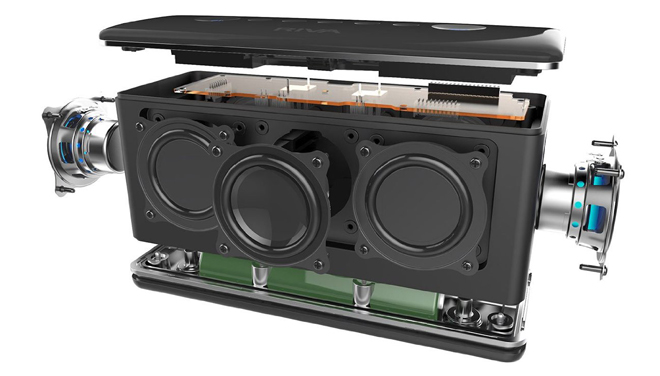
The speaker measures 9.1-inches x 3.5-inches x 4.1-inches and weighs 3.5 lb with a handsome black finish (a white model is also available), giving it a sturdy but still very portable and compact form factor. The device features three ADX 60 mm full range proprietary drivers and four ADX custom dual piston bass radiators. Amplification power is rated at 45 watts RMS, and battery life is rated for 26+ hours at 75 dB. A dual noise and echo canceling microphone is integrated as well for speakerphone capabilities and the Bluetooth range is listed as 33 feet.
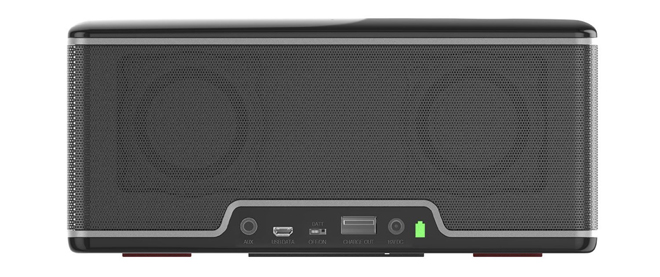
On the back panel of the speaker is a removable I/O cover that can protect against dust and splashes. Once removed, a row of inputs and indictors is revealed, including an auxiliary 3.5 input for non-Bluetooth devices, a USB data input for software upgrades, a battery On/Off button, an iPod/iPhone input, a 19V DC power adapter input, and a battery level indicator that changes color depending on the charge level.

Moving on to the glossy top panel of the device, customers will find a series of touch-sensitive controls that can be activated by a simple tap. There's a Power On/Off button, a Trillium Surround button, an Input button, a Mute button, Volume Down/Up buttons, and a Turbo button. Once toggled, the buttons glow blue and a voice will speak the selection, letting you know that the desired feature has been engaged. In addition, the panel will even light up if a user merely waves their hand close to the top, making it easy to see the selection icons.
Upon initial use, the Turbo X comes partially charged and the user's manual recommends that customers immediately fully charge the unit. Likewise, the manual also recommends that users break in the speaker by playing it at 50% volume for 3 hours. Finally, customers with an Android or iOS mobile device can also download the RIVA Ground Control App to enable mobile controls for volume and playback.
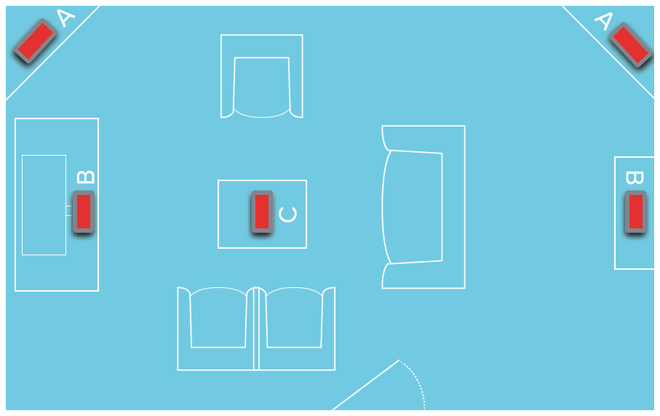
Once charged and ready to go, customers simply need to select a spot to place the speaker. RIVA recommends putting the unit in the corner of the room about 3-6 inches from the wall, allowing for the speaker to take advantage of the environment's natural acoustics. If that's not an option, placement in front of any solid, reflective surface, or merely toward the center of the room, are also good bets as well. When the speaker is turned on, it automatically enters pairing mode and will connect with any supported Bluetooth playback device that you choose to pair it with. For the purposes of this review, I primarily listened to audio from my Samsung Galaxy S4 smartphone. Finally, the device supports SBC, AAC, and aptX audio codecs for high quality wireless playback.
Performance
For my first round of testing, I placed the Turbo X on a dresser lined up against the back of my bedroom (which is relatively small and very narrow in size), and paired the speaker with my smartphone through Bluetooth. From there, I played a wide range of music files, including MP3 and M4a tracks, and streaming music through Spotify. Initially, the speaker sounded a bit muddy and harsh with slightly indistinct vocals, but after the recommended break in time and an increase in volume, the Turbo X really started to shine, revealing very impressive audio performance for a Bluetooth speaker of this size.
Throughout all of the tracks I demoed -- including selections from Radiohead, The Beatles, Nora Jones, Gnarls Barkley, ACDC, Pink Floyd, Daft Punk, David Bowie, Arcade Fire, Rush, and the catchy, twee hipster ear-candy that is the 'God Help the Girl' soundtrack -- the Turbo X proved itself to be a versatile, nicely balanced, room-filling speaker with a surprisingly robust low-end, solid mids, and relatively clean highs. Sure, the unit isn't on the same level as full-sized speakers and it can still sound just a bit harsh and flat even when broken-in, but in the realm of mobile Bluetooth offerings, the sound performance here is almost in a class of its own, completely eschewing the tiny, boxy quality found from most portable speakers.
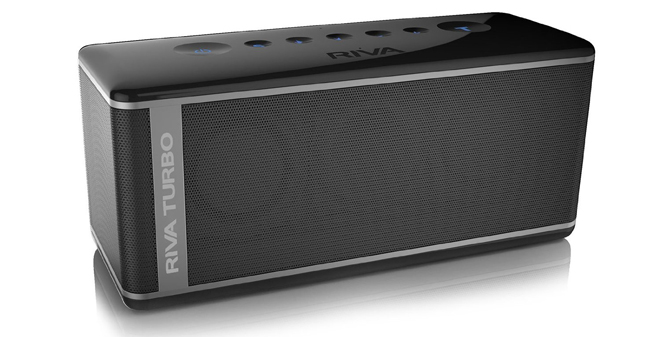
Vocals were lush and warm in gentle offerings like Nora Jones' "Don't Know Why," while individual instruments were easily distinguishable in classical music selections, and bass activity offered solid kick during more aggressive offerings like ACDC's "You Shook Me All Night Long." Hell, there were times when I even felt some subtle floor-vibrations from the low-end. With that said, more forceful rock tracks did have a tendency to become less distinct and just a tad boomy, losing some of the clarity found in the less busy songs.
Considering the size of my room, I usually had the volume set at around 6 or 7 (out of 10), but the speaker could easily push more decibels without any issues. In fact, the Turbo X not only excels at higher volume levels, it actually sounds even better when dialed up, always maintaining clarity without distortion.
On that note, I also demoed the unit in a much larger living room setting, placing the speaker on a table toward the side of the room, and then in front of the television (where one might normally place a center channel speaker). In both cases, with the volume now dialed up to the 9 or 10 range, the Turbo X once again verified its premium audio quality claims, providing room-filling audio that sounded even more expansive in a larger environment. Again, the sound quality remained surprisingly rich and spacious for a mobile speaker with no discernable issues (outside of some minor harshness on some tracks) -- and this was all with content being played wirelessly through Bluetooth, a technology that hasn't always been known for quality audio reproduction.
For my last round of testing, I disengaged the Bluetooth pairing and decided to give the speaker's wired performance a go. Though the 3.5 mm to RCA connector is a nice inclusion, I quickly realized that I didn't actually own any playback devices that still offer such outputs. Considering the connection options found on most modern devices, an optical or HDMI input would have been a lot more useful if the Turbo X is really going to bill itself as a viable option for movies and games. Thankfully, I could still test the speaker plugged into my desktop computer using the included 3.5 mm to 3.5 mm connector, offering a more compact alternative to a traditional 2.1 system.
With the speaker comfortably positioned in front of my monitor (like one might place a soundbar), I played back several MP3 tracks and watched numerous film trailers and clips to get a sense for the speaker's movie performance. Playback was full and engaging, and while the dynamic range was not nearly as wide as on my Klipsch desktop speaker setup, the quality was quite impressive with full dialogue and lively effects on the movie samples.
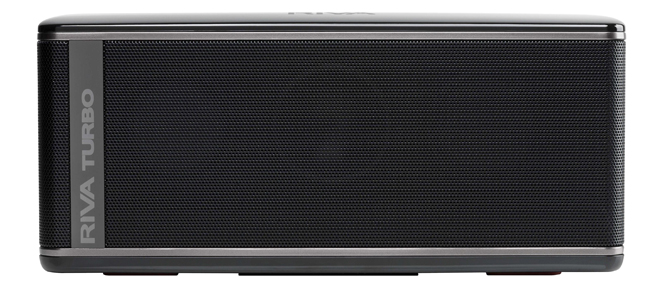
On the battery life front, the speaker also turned in rather impressive performance. After each hour of use with the volume hovering between 9 and 10, the speaker only drained about 4-5%, promising about 20-25 hours of use when set toward the max output. It should be noted, however, that the device does still drain power even when in stand-by mode (about 10 percent in 24 hours).
When it comes to Bluetooth stability, performance was also great. The manual states support for a distance of about 33 feet, and in practice this held true. In fact, as long as I stayed perfectly still with my mobile device, I could even get a few feet further before major playback stuttering or a complete disconnect occurred.
With all that said, even with its premium audio performance, a portable speaker of this type does still have its clear drawbacks. Due to the small size of the unit, any sense of actual stereo separation is essentially non-existent, limiting the product's appeal as an actual desktop 2.1 substitute. Of course, the speaker is primarily designed for portability and ease of use, and as a room-filling or outdoor mobile audio product, the Turbo X really excels, offering a great, compact music solution for parties and casual around-the-house listening that doesn't sacrifice quality for portability.
Features
Outside of its normal Bluetooth and wired playback, the Turbo X also includes a few extra features and listening modes. First up, is the speaker's handy mobile app for Android and iOS devices. Once installed, this convenient app offers simple playback options, toggles for the device's different modes, and a very useful battery level meter that tells you exactly how much power you have left.
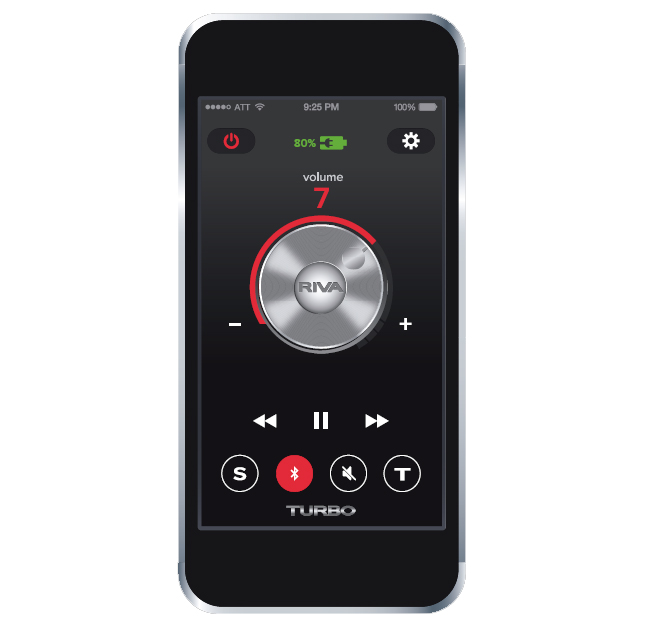
Next up, is the speaker's Turbo Mode which literally turns the volume level up to 11, allowing users to enjoy up to 100 dB of audio exactly the way that 'Spinal Tap' intended. In practice, this mode worked exactly as advertised, boosting the sound to even greater volume levels. With that said, in my test environments, the extra volume was never really needed and the Turbo Mode did start to introduce some notable distortion that was not evident at the previously maxed out levels. Likewise, Turbo Mode will significantly reduce battery life, with only an estimated 6+ hours of use when fully maxed out. But then again, the speaker does play a badass engine revving noise when you turn the mode on… so that might be worth the reduced playback time alone.
In addition to the Turbo Mode, the speaker also includes a Trillium Surround mode. This option is designed for use with movies and games and aims to expand the soundfield with greater ambiance. I toggled this mode on and off several times with a variety of content, including movies and even some music tracks. While I did notice slightly more directional separation between effects and a faintly more spacious quality in some instances, for the most part, I didn’t really observe any major advantages or disadvantages to this mode.
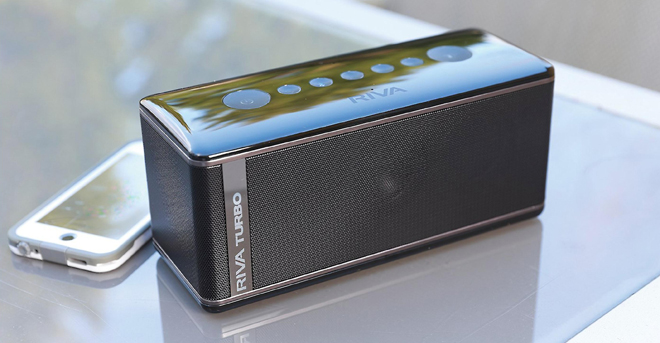
Outside of audio playback options, the Turbo X also features a speakerphone mode. When paired with your smartphone, the device can be used to receive calls allowing users to hear and talk through the speaker and its built-in microphone. Unfortunately, this option proved to be a bit uneven. On the one hand, sound quality on my end was always great, resulting in crisp audio reproduction of the caller that was easy to hear. On the other hand, everyone I called complained about it being hard to hear me on their end, noting an echoey, amplified quality that made it sound like I was in a tunnel. With that said, though not ideal, my gracious speakerphone test subjects could still technically make out was I saying, even if I spoke from several feet away from the unit.
Finally, the speaker includes the ability to charge smartphones and tablets through its integrated USB port, making it a useful power supply when on the go. Of course, using this option will drain the speaker's battery life, but if you happen to find yourself accidently stranded in the wilderness with no food or water, a working smartphone might be more important than some rocking tunes. In testing, this feature worked great, letting me charge my Galaxy S4 through the speaker and play music from it at the same time.
Conclusion
While a portable Bluetooth speaker is never going to be equal in performance or connectivity to a full-fledged speaker system, and there are some minor issues here and there, when it comes to the mobile audio market, the RIVA Turbo X is a genuinely impressive device. With its surprisingly robust low-end, solid mids and highs, great battery life, and high-class design, the speaker really lives up to its promise as a premium Bluetooth product.
Of course, with that premium quality does come a comparatively high price tag. At $350, this is not exactly a budget item -- but then again, it's not really claiming to be one. This is a Bluetooth device geared toward customers who want something a bit more substantial from their speaker than the mediocre performance found on other run-of-the-mill mobile offerings. In other words, in this price and size range, this is probably as close to an audiophile friendly Bluetooth portable speaker as there is.
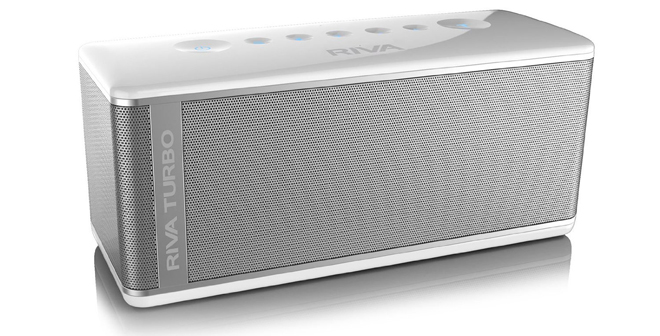
The RIVA Turbo X speaker is now available for $350 in black or white color options. In addition, for users on the go, RIVA sells a handy $30 travel bag with a durable nylon exterior, a soft velvet lined interior with a layer of protective padding, and an exterior pocket for cables. If you're willing to pay the extra cash in order to enjoy the premium audio quality, then this speaker comes highly recommended!












